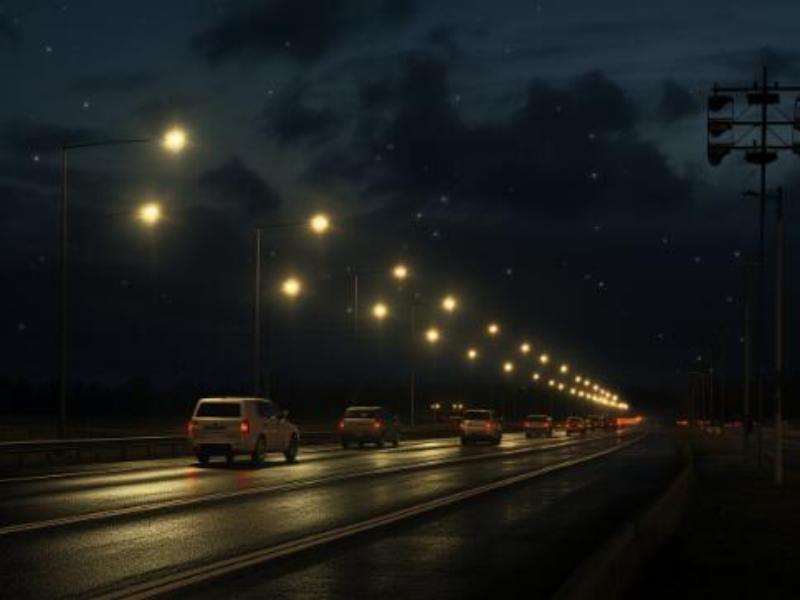Llums d'autopistatenen un paper vital per garantir la seguretat i la visibilitat dels conductors i vianants a la carretera. Els llums es col·loquen estratègicament al llarg de l'autopista per proporcionar il·luminació a la nit i durant condicions meteorològiques adverses. Un aspecte important d'un llum d'autopista és la seva alçada, ja que afecta directament la seva eficàcia per proporcionar una il·luminació adequada i garantir la seguretat de tothom a la carretera.
Pel que fa a l'alçada dels llums d'autopista, hi ha diversos factors importants a tenir en compte. L'alçada dels llums es determina en funció de diverses consideracions, com ara el límit de velocitat de la carretera, la curvatura de la carretera i l'entorn circumdant. A més, l'alçada dels fars també juga un paper important per reduir l'enlluernament del conductor i garantir una il·luminació uniforme a la carretera.
L'alçada estàndard dels llums de carretera es determina normalment en funció de les directrius i regulacions establertes per les autoritats de trànsit. Per exemple, als Estats Units, l'Administració Federal d'Autopistes (FHWA) proporciona directrius per al disseny i la instal·lació de llums de carretera, incloses les seves especificacions d'alçada. Segons la FHWA, l'alçada dels llums de carretera s'ha d'optimitzar per proporcionar una il·luminació adequada i alhora minimitzar el potencial d'enlluernament i contaminació lumínica.
L'alçada dels llums de les autopistes és particularment important en zones amb límits de velocitat més alts. En aquests llocs, els llums s'han de col·locar a una alçada suficient per proporcionar una distribució de la llum àmplia i uniforme per tota la carretera. Això ajuda a garantir que el conductor tingui una visió clara de la carretera, reduint el risc d'accidents i millorant la seguretat general. A més, l'alçada dels llums minimitza les ombres projectades pel vehicle, millorant encara més la visibilitat del conductor.
En zones amb carreteres corbes o costerudes, l'alçada dels llums de carretera esdevé encara més important. La curvatura de la carretera afecta la visibilitat dels llums, per la qual cosa cal tenir en compte acuradament l'alçada dels llums per garantir que il·luminin eficaçment tota la carretera. De la mateixa manera, en zones amb condicions meteorològiques variables, cal optimitzar l'alçada dels llums per proporcionar una il·luminació adequada durant la pluja, la boira o la neu.
A més de les consideracions de visibilitat i seguretat, l'alçada dels llums de les carreteres també minimitza la contaminació lumínica i l'impacte ambiental. En col·locar els llums a altures òptimes, les autoritats de transport poden reduir la quantitat de llum projectada cap amunt i evitar causar contaminació lumínica. Això és particularment important en zones properes a zones residencials i hàbitats naturals, on la contaminació lumínica excessiva pot afectar negativament la vida silvestre i la salut humana.
L'alçada dels semàfors de l'autopista també és un factor a l'hora de reduir l'enlluernament del conductor. L'enlluernament dels semàfors massa brillants o mal col·locats pot afectar greument la capacitat del conductor per veure la carretera, cosa que pot provocar un accident. En determinar l'alçada adequada dels semàfors de l'autopista, les autoritats de trànsit poden minimitzar l'enlluernament i crear un entorn de conducció més segur per a tothom a la carretera.
En els darrers anys, els avenços en la tecnologia d'il·luminació també han afectat l'alçada dels llums de les autopistes. La tecnologia LED, en particular, proporciona solucions d'il·luminació més eficients i precises per a les autopistes. Els llums LED no només són més eficients energèticament, sinó que també permeten un millor control de la distribució de la llum, cosa que permet una major flexibilitat a l'hora de determinar l'alçada òptima dels llums de les autopistes.
En conclusió, elalçada dels llums de l'autopistajuga un paper vital per garantir la seguretat viària, la visibilitat i l'impacte ambiental. Si consideren acuradament factors com la velocitat de la carretera, la curvatura i l'entorn circumdant, les autoritats de transport poden determinar l'alçada adequada dels llums de les carreteres, contribuint en última instància a una infraestructura viària més segura i sostenible. A mesura que la tecnologia continuï avançant, l'alçada dels llums de les carreteres continuarà sent una consideració clau per proporcionar solucions d'il·luminació eficients i efectives per a les carreteres.
Data de publicació: 11 de gener de 2024

